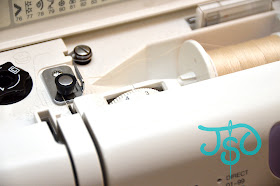
If you're quilting Jelly Roll Race quilts along with us for QuiltWest, you'll know that I requested participants use 100 percent cotton thread for both the piecing and the quilting. I have a confession to make: I pretty much hated quilting with cotton thread until a fellow long arm quilter gave me some tips...
Ever wonder why most "serious" quilters will tell you to use cotton thread? There are a couple of theories. First, Modern quilters (with a big M) want to be able to wash their quilts, and using cotton thread allows the thread to shrink similarly to the quilt, as opposed to polyester and blended threads, which may shrink unpredictably or not at all. The other big reason I hear over and over is that the blended threads are stronger than the 100 percent cotton fabric used to make most quilts, and as the quilt ages, the blended threads can stress and break the woven strands in the fabric.
Not everyone agrees with this theory. One of my favorite long arm quilters, Angela Walters, talks openly about using beautiful threads regardless of their composition. I know early in my quilting journey, I loved the look of the pretty polyester embroidery threads, like this one from Isacord (right) and the Wonderfil Metallic (left) here. (I still like to vary my thread choice from time to time, but most people have asked me to quilt their quilts with cotton, and it's just easier to build a stash of colors in the same product.)
But my initial preference for polyester wasn't just about the look. Frankly, I found cotton thread positively infuriating. It constantly broke in my long arm machine...like, every couple of minutes. Cotton just doesn't have as much elasticity as the poly blend threads. It made me crazy until a more experienced long arm quilter told me to do two things:
First, if you live in a low humidity area, (we were living in the Colorado mountains at the time), store your cotton thread in a ziploc bag with a damp cotton ball and keep it in the refrigerator. (Crazy, right? But it works!)
Second, and this one has been the game-changer: Pick up a product called Sewer's Aid.
This stuff is a thread lubricant that doesn't hurt your machine or your fabric, but it allows the cotton to pass through your machine more smoothly and gives it a bit more elasticity. Just run a bead of the Sewer's Aid down the length of your spool. (If you're using a great big cone on a long arm, run two to three beads down the spool.)
It will soak in quickly and then you can start sewing.
Another thing -- Don't forget to adjust the tension on your machine. That's pretty much a given every time you switch threads on a long arm quilter, but it's less instinctive on a domestic machine if you use all-purpose thread for everything else. I don't change the bobbin tension on my domestic machine (the top-load bobbin case doesn't allow it), so I have to pump the top thread tension up a couple of notches -- depending on the weight of the thread -- to balance the tension and get pretty, even stitches. If your only choice, like mine, is to crank the tension up, you'll need the thread lubricant even more.
Pay attention to the thread weight before you buy it! "Weight" to thread is what "gauge" is to wire. It refers to the size of the shaft of the thread. The lower the number, the thicker the thread. I've been known to quilt with 30, 40 and 50 weight cotton thread. I once bought a super-thick 12 weight, and though it looked chunky and cool on the fabric, it jacked my long arm when it got caught in the bobbin race assembly and it left righteous amounts of lint. I'm just saying, I don't personally recommend anything larger than 30 wt.
By the way, can you tell I'm a sucker for variegated (multicolor) threads? :)






